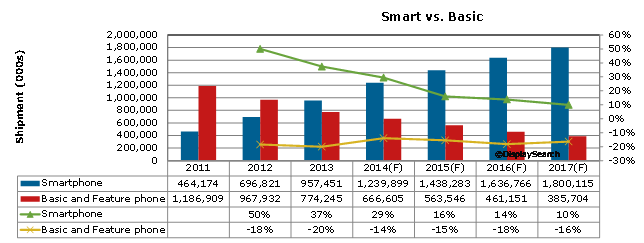2013 will be a year of drastic changes in the smartphone market, both in terms of shipments and market share of brands; even product specifications, average unit prices, and business behavior have all undergone dramatic changes, and the main sources of these are from high-end The growth of the mobile phone market (selling more than US $ 400) was lower than expected, resulting in changes from the source supply chain to the end market.
NPD DisplaySearch estimates that global mobile phone shipments in 2013 will be 1.7 billion units, which is about 4% higher than the mobile phone market in 2012. Although the growth of global mobile phone shipments has slowed, the biggest difference from the past is that smartphone shipments will surpass features and general mobile phones. Smartphone shipments will account for 55% of total shipments this year, reaching 956 million units. Most of the growth force comes from low-end and mid-range mobile phones. Mobile phone shipments under US $ 400 have a compound annual growth rate of more than 60% in 2013. It is estimated that shipments will reach more than 533 million units. The products of low-end and mid-range mobile phones are not dominated by the well-known international brands, such as Apple and HTC, because the product life cycle of low-end and low-end mobile phones is shorter, and requires a faster product development process and a more complex supply chain Management for profit in low-margin markets. It is also because of the rapid growth of the low-end mobile phone market that many international brands faced a slowdown or even a decline in 2013, making the prediction of 2014 development more market-shuffled because of the continuous fermentation, because the supply chain has become fierce Changes, low-end mobile phone manufacturers can gradually obtain high-spec components at lower prices.
The growth of the Apple iPhone has slowed, whether it has a dramatic impact on the smartphone market or even the entire supply chain. NPD DisplaySearch estimates that the annual compound annual growth of Apple iPhone shipments in 2013 will be 10%, compared with 46% in 2012. The main reason for Apple's slowdown is that in addition to the high saturation of high-end smartphones in advanced countries such as North America and Europe, iPhone shipments are not one of the reasons for the rapid growth of developing countries. The same phenomenon also happened in HTC, Nokia, RIM, Motorola and even some high-end models of Samsung. In 2013, they faced shipments that could not have a compound annual growth rate of more than 20% or even 30% as before. However, market shipments continue to increase upwards, replaced by Chinese brands and other second-tier brands, with a lower gross profit and rapid product replacement rate, gaining a leading position in the low-end market.
When the shipment growth of high-end models slows down, it will cause great changes in the supply chain. Brands have very high requirements for the specifications of components of high-end models. At the same time, in order to ensure the time of product shipment, many brands have restricted major suppliers in the past and locked production capacity. When the growth of high-end models slows down, it will lead to oversupply in the production capacity of high-end component suppliers, and therefore will make manufacturers face the need to reduce specifications and prices to low-end product market competition, and even start to consider Doing semi-finished products business in order to benefit the excess capacity can be operated; this phenomenon will allow brands mainly in the low-end smartphone market to gradually obtain higher specifications of components, and there will be many middle-end smartphones and high-end smartphones. The difference in the specifications of first-class mobile phones is gradually narrowing. NPD DisplaySearch estimates that by 2015, the market share of smartphones above US $ 400 will be less than 30%, while in 2012, high-end mobile phones will have a market share of 53%, and the market share will not be as usual. In the past few years, component suppliers have been continuously investing in production capacity due to the rapid growth of the market, especially the production capacity of high-end technology. However, the main growth momentum in the next few years will all occur in low-end and mid-range phones, so it can be predicted that in the future, more manufacturers of smart phone components capable of producing high specifications will enter the market with lower gross profit. .
In summary, smartphones will continue to grow, but in order to have higher market penetration and replace feature phones, more low-end smartphones will appear in the market after 2013, and shipments will continue to increase, regardless of brand Or the supply chain will reshuffle after 2013.
Figure 1. Global mobile phone shipment forecast for 2011-2017

Data source: NPD DisplaySearch Q2'13 Smart Phone Quarterly
CSRME Safety Controller is developed for standard GB27607. By monitoring machine tool safety related equipment, the security of machine control system can meet the requirements of GB27607, and its security meets the requirements of ISO13849-1 (PLe) and IEC61508 (SIL3).
With rich interfaces, CSRME has limited programmable function. It can simultaneously replace many different types of safety control modules or safety PLCs, thus greatly simplifying the safety design of machine control systems and reducing cost.
Safety Controller
Safety Controller,Modular Safety Controller,Safety Controller,Electrical Safety Controller,Programmable Logic Controller,Banner Safety Controller
Jining KeLi Photoelectronic Industrial Co.,Ltd , https://www.sdkelien.com